wheel size TOYOTA YARIS 2019 Owners Manual (in English)
[x] Cancel search | Manufacturer: TOYOTA, Model Year: 2019, Model line: YARIS, Model: TOYOTA YARIS 2019Pages: 600, PDF Size: 6.11 MB
Page 64 of 600
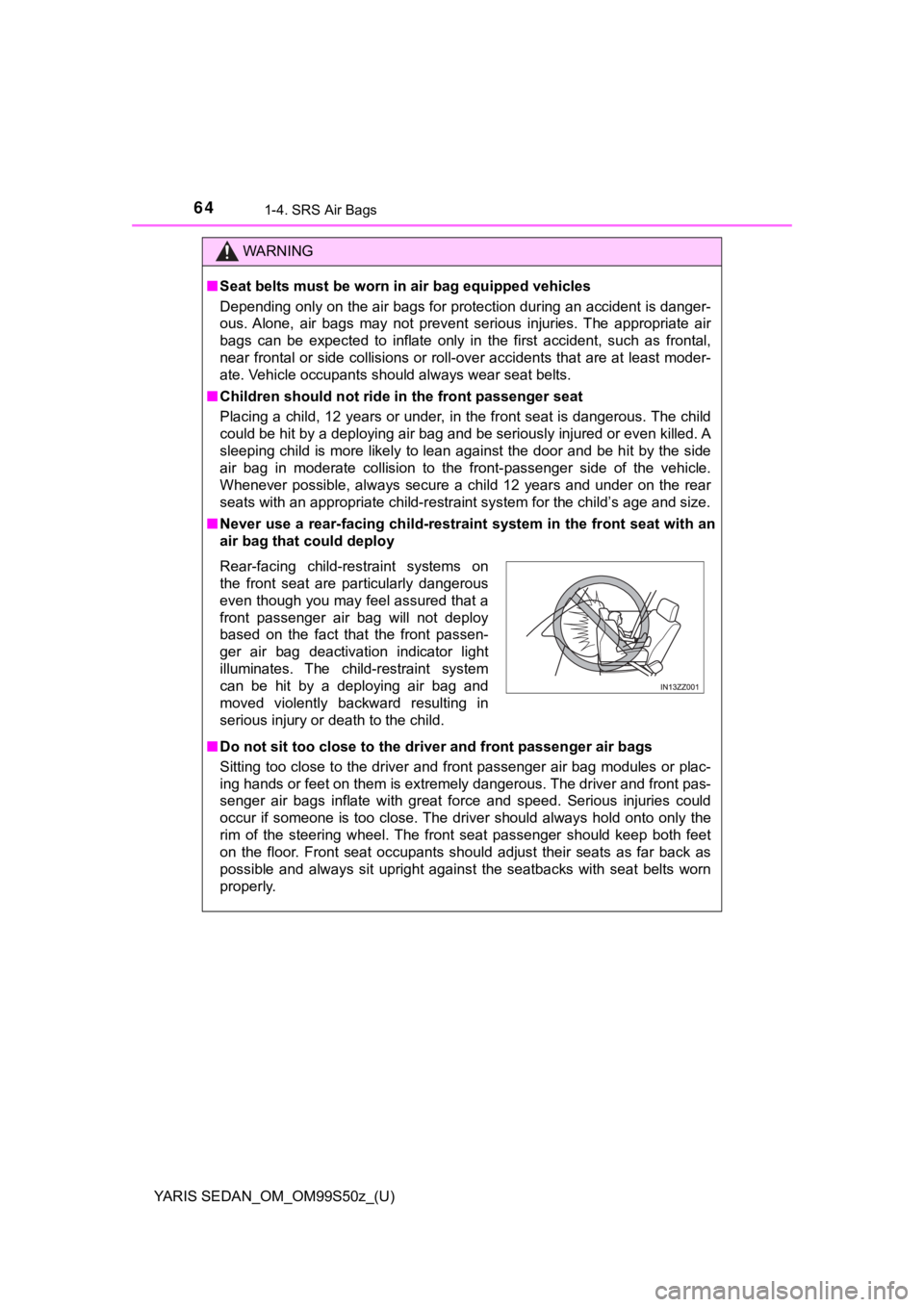
64
YARIS SEDAN_OM_OM99S50z_(U)
1-4. SRS Air Bags
WARNING
■Seat belts must be worn in air bag equipped vehicles
Depending only on the air bags for protection during an acciden t is danger-
ous. Alone, air bags may not prevent serious injuries. The appr opriate air
bags can be expected to inflate only in the first accident, suc h as frontal,
near frontal or side collisions or roll-over accidents that are at least moder-
ate. Vehicle occupants should always wear seat belts.
■ Children should not ride in the front passenger seat
Placing a child, 12 years or under, in the front seat is danger ous. The child
could be hit by a deploying air bag and be seriously injured or even killed. A
sleeping child is more likely to lean against the door and be h it by the side
air bag in moderate collision to the front-passenger side of th e vehicle.
Whenever possible, always secure a child 12 years and under on the rear
seats with an appropriate child-restraint system for the child’s age and size.
■ Never use a rear-facing child-restraint system in the front sea t with an
air bag that could deploy
■ Do not sit too close to the driver and fron t passenger air bags
Sitting too close to the driver and front passenger air bag modules or plac-
ing hands or feet on them is extremely dangerous. The driver an d front pas-
senger air bags inflate with great force and speed. Serious injuries could
occur if someone is too close. The driver should always hold on to only the
rim of the steering wheel. The front seat passenger should keep both feet
on the floor. Front seat occupants should adjust their seats as far back as
possible and always sit upright against the seatbacks with seat belts worn
properly.
Rear-facing child-restraint systems on
the front seat are particularly dangerous
even though you may feel assured that a
front passenger air bag will not deploy
based on the fact that the front passen-
ger air bag deactivation indicator light
illuminates. The child-restraint system
can be hit by a deploying air bag and
moved violently backward resulting in
serious injury or death to the child.
Page 138 of 600
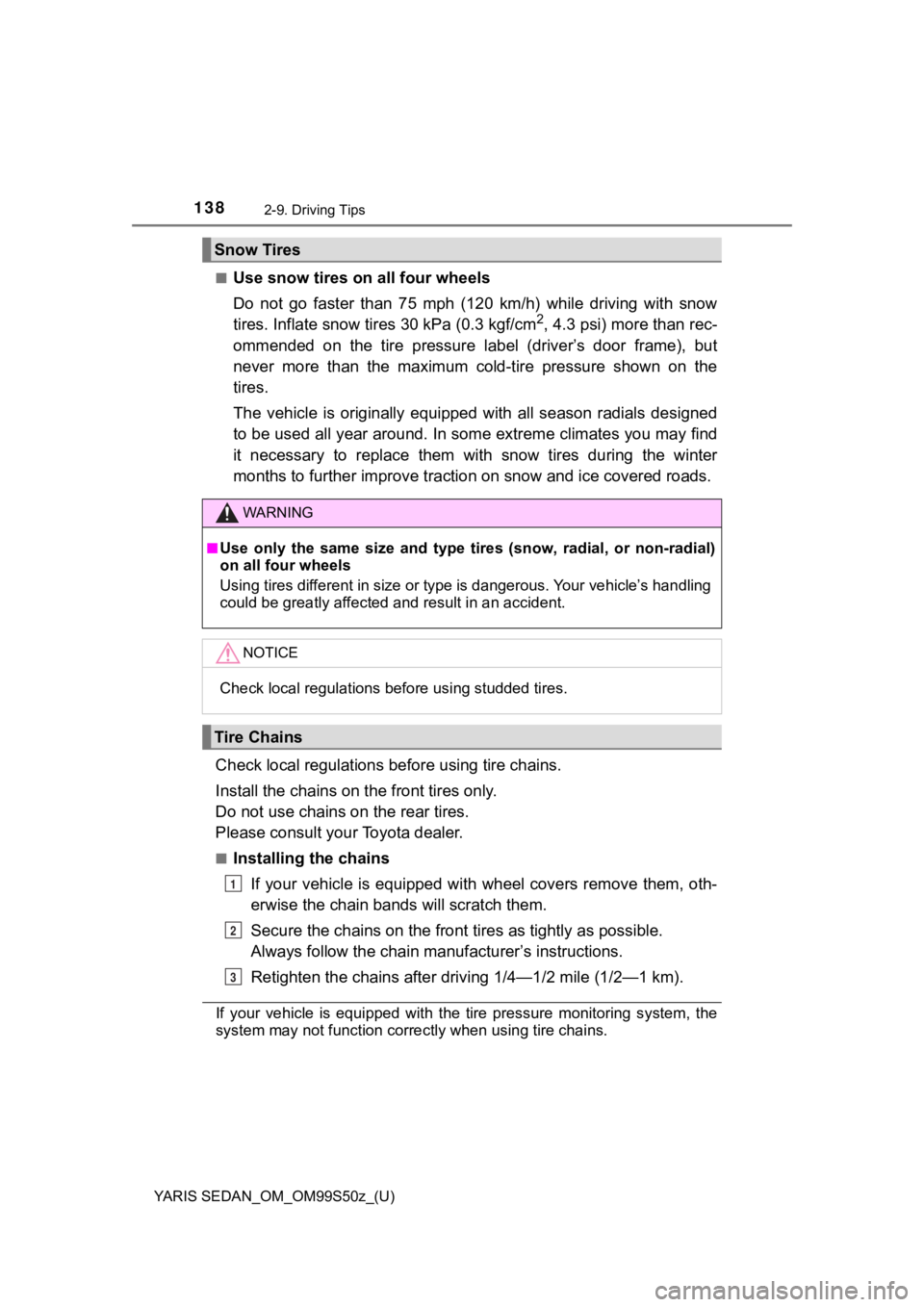
138
YARIS SEDAN_OM_OM99S50z_(U)
2-9. Driving Tips
■Use snow tires on all four wheels
Do not go faster than 75 mph (120 km/h) while driving with snow
tires. Inflate snow tires 30 kPa (0.3 kgf/cm
2, 4.3 psi) more than rec-
ommended on the tire pressure label (driver’s door frame), but
never more than the maximum cold-tire pressure shown on the
tires.
The vehicle is originally equipped with all season radials desi gned
to be used all year around. In some extreme climates you may fi nd
it necessary to replace them wit h snow tires during the winter
months to further improve tracti on on snow and ice covered road s.
Check local regulations before using tire chains.
Install the chains on the front tires only.
Do not use chains o n the rear tires.
Please consult your Toyota dealer.
■Installing the chains
If your vehicle is equipped with wheel covers remove them, oth-
erwise the chain bands will scratch them.
Secure the chains on the front tires as tightly as possible.
Always follow the chain manuf acturer’s instructions.
Retighten the chains after dri ving 1/4—1/2 mile (1/2—1 km).
If your vehicle is equipped with the tire pressure monitoring s ystem, the
system may not function correctly when using tire chains.
Snow Tires
WARNING
■Use only the same size and type tires (snow, radial, or non-rad ial)
on all four wheels
Using tires different in size or type is dangerous. Your vehicl e’s handling
could be greatly affected and result in an accident.
NOTICE
Check local regulations before using studded tires.
Tire Chains
1
2
3
Page 207 of 600
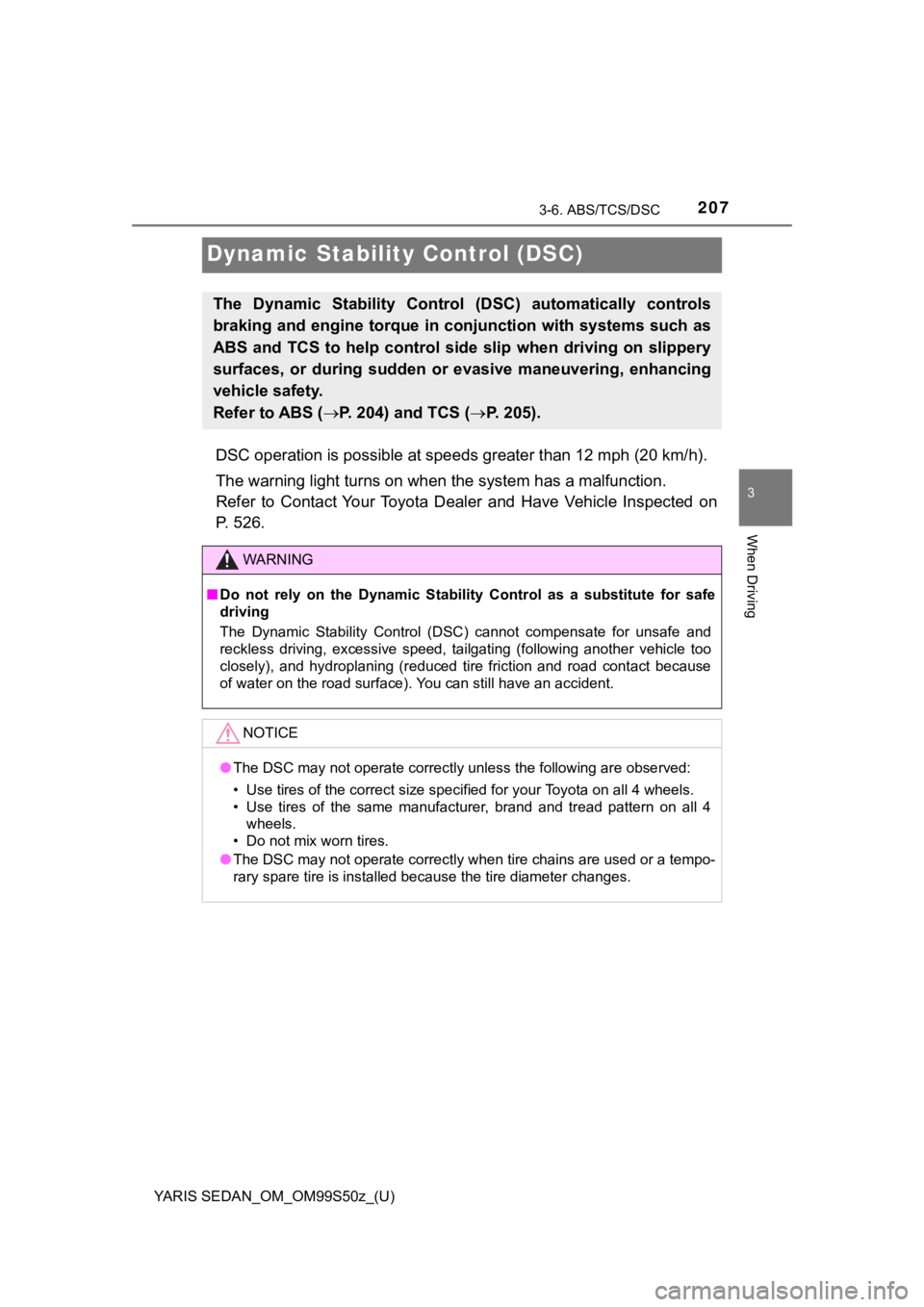
207
YARIS SEDAN_OM_OM99S50z_(U)
3-6. ABS/TCS/DSC
3
When Driving
Dynamic Stability Control (DSC)
DSC operation is possible at speeds greater than 12 mph (20 km/h).
The warning light turns on when the system has a malfunction.
Refer to Contact Your Toyota Dealer and Have Vehicle Inspected on
P. 526.
The Dynamic Stability Control ( DSC) automatically controls
braking and engine torque in c onjunction with systems such as
ABS and TCS to help control si de slip when driving on slippery
surfaces, or during sudden or e vasive maneuvering, enhancing
vehicle safety.
Refer to ABS ( P. 204) and TCS ( P. 205).
WARNING
■Do not rely on the Dynamic Stabil ity Control as a substitute for safe
driving
The Dynamic Stability Control (DSC) cannot compensate for unsaf e and
reckless driving, excessive speed, tailgating (following anothe r vehicle too
closely), and hydroplaning (reduced tire friction and road cont act because
of water on the road surface). You can still have an accident.
NOTICE
● The DSC may not operate correctly unless the following are obse rved:
• Use tires of the correct size specified for your Toyota on all 4 wheels.
• Use tires of the same manufacturer, brand and tread pattern on all 4 wheels.
• Do not mix worn tires.
● The DSC may not operate correctly when tire chains are used or a tempo-
rary spare tire is installed because the tire diameter changes.
Page 221 of 600
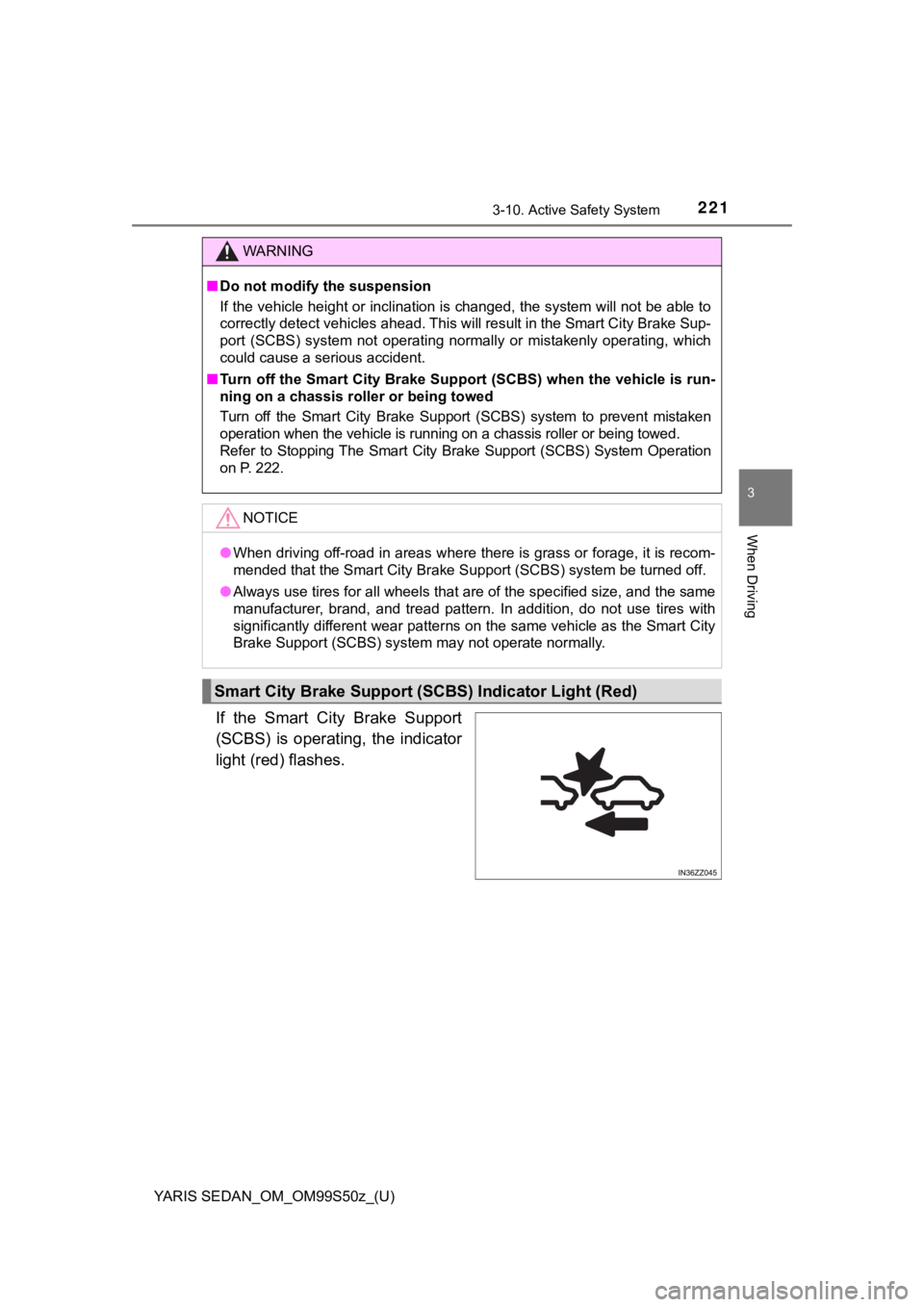
YARIS SEDAN_OM_OM99S50z_(U)
2213-10. Active Safety System
3
When Driving
If the Smart City Brake Support
(SCBS) is operating, the indicator
light (red) flashes.
WARNING
■Do not modify the suspension
If the vehicle height or inclination is changed, the system will not be able to
correctly detect vehicles ahead. This will result in the Smart City Brake Sup-
port (SCBS) system not operating normally or mistakenly operati ng, which
could cause a serious accident.
■ Turn off the Smart City Brake S upport (SCBS) when the vehicle is run-
ning on a chassis roller or being towed
Turn off the Smart City Brake Su pport (SCBS) system to prevent mistaken
operation when the vehicle is running on a chassis roller or be ing towed.
Refer to Stopping The Smart City Brake Support (SCBS) System Op eration
on P. 222.
NOTICE
● When driving off-road in areas where there is grass or forage, it is recom-
mended that the Smart City Brake Support (SCBS) system be turne d off.
● Always use tires for all wheels that are of the specified size, and the same
manufacturer, brand, and tread pattern. In addition, do not use tires with
significantly different wear patterns on the same vehicle as th e Smart City
Brake Support (SCBS) system may not operate normally.
Smart City Brake Support (S CBS) Indicator Light (Red)
Page 232 of 600

232
YARIS SEDAN_OM_OM99S50z_(U)
3-12. Tire Pressure Monitoring System
NOTICE
●Each tire, including the spare (if provided), should be checked monthly
when cold and inflated to the inflation pressure recommended by the
vehicle manufacturer on the vehi cle placard or tire inflation pressure
label. (If your vehicle has tires of a different size than the size indicated
on the vehicle placard or tire i nflation pressure label, you sh ould deter-
mine the proper tire inflati on pressure for those tires.)
As an added safety feature, your vehicle has been equipped with a tire
pressure monitoring system (TPMS ) that illuminates a low tire pres-
sure telltale when one or more of your tires is significantly u nder-
inflated. Accordingly, when the low tire pressure telltale illuminates,
you should stop and check your tires as soon as possible, and i nflate
them to the proper pressure. Driving on a significantly under-i nflated
tire causes the tire to overheat and can lead to tire failure. Under-infla-
tion also reduces fuel efficiency and tire tread life, and may affect the
vehicle’s handling an d stopping ability.
Please note that the TPMS is not a substitute for proper tire m ainte-
nance, and it is the driver’s r esponsibility to maintain correc t tire pres-
sure, even if under-inflation has not reached the level to trig ger
illumination of the TPMS lo w tire pressure telltale.
Your vehicle has also been equipped with a TPMS malfunction ind ica-
tor to indicate when the syste m is not operating properly.
The TPMS malfunction indicator i s combined with the low tire pressure
telltale. When the system detects a malfunction, the telltale will flash
for approximately one minute an d then remain continuously illumi-
nated. This sequence will contin ue upon subsequent vehicle star t-ups
as long as the malfunction exists . When the malfunction indicator is
illuminated, the system may not be able to detect or signal low tire
pressure as intended. TPMS malfunctions may occur for a variety of
reasons, including the installation of replacement or alternate tires or
wheels on the vehicle that prevent the TPMS from functioning pr operly.
Always check the TPMS malfunction telltale after replacing one or
more tires or wheels on your veh icle to ensure that the replacement or
alternate tires and wheels allow the TPMS to continue to functi on prop-
erly.
●To avoid false readings, the system samples for a little while before
indicating a problem. As a res ult it will not instantaneously register a
rapid tire deflation or blow out.
Page 459 of 600
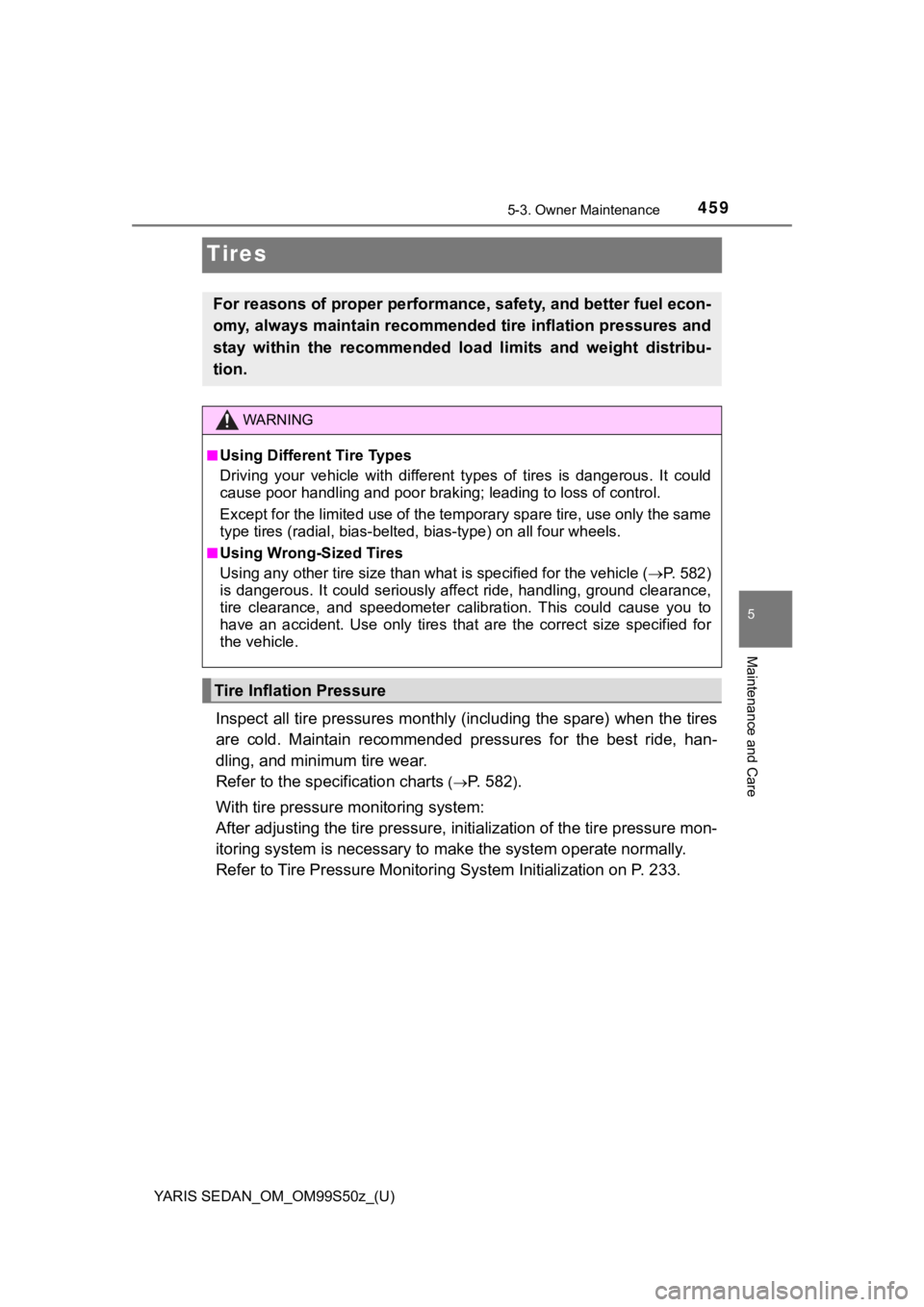
459
YARIS SEDAN_OM_OM99S50z_(U)
5-3. Owner Maintenance
5
Maintenance and Care
Tires
Inspect all tire pressures monthly (including the spare) when the tires
are cold. Maintain recommended pressures for the best ride, han -
dling, and minimum tire wear.
Refer to the spec ification charts
(P. 5 8 2).
With tire pressure m onitoring system:
After adjusting the tire pressur e, initialization of the tire p ressure mon-
itoring system is necessary to m ake the system operate normally .
Refer to Tire Pressure Monitorin g System Initialization on P. 233.
For reasons of proper performan ce, safety, and better fuel econ-
omy, always maintain recommended tire inflation pressures and
stay within the recommended load limits and weight distribu-
tion.
WARNING
■Using Different Tire Types
Driving your vehicle with differ ent types of tires is dangerous . It could
cause poor handling and poor bra king; leading to loss of control.
Except for the limited use of the temporary spare tire, use onl y the same
type tires (radial, bi as-belted, bias-type) on all four wheels.
■Using Wrong-Sized Tires
Using any other tire size than wh at is specified for the vehicle (P. 5 8 2 )
is dangerous. It could seriously affect ride, handling, ground clearance,
tire clearance, and speedometer calibration. This could cause y ou to
have an accident. Use only tires that are the correct size spec ified for
the vehicle.
Tire Inflation Pressure
Page 464 of 600
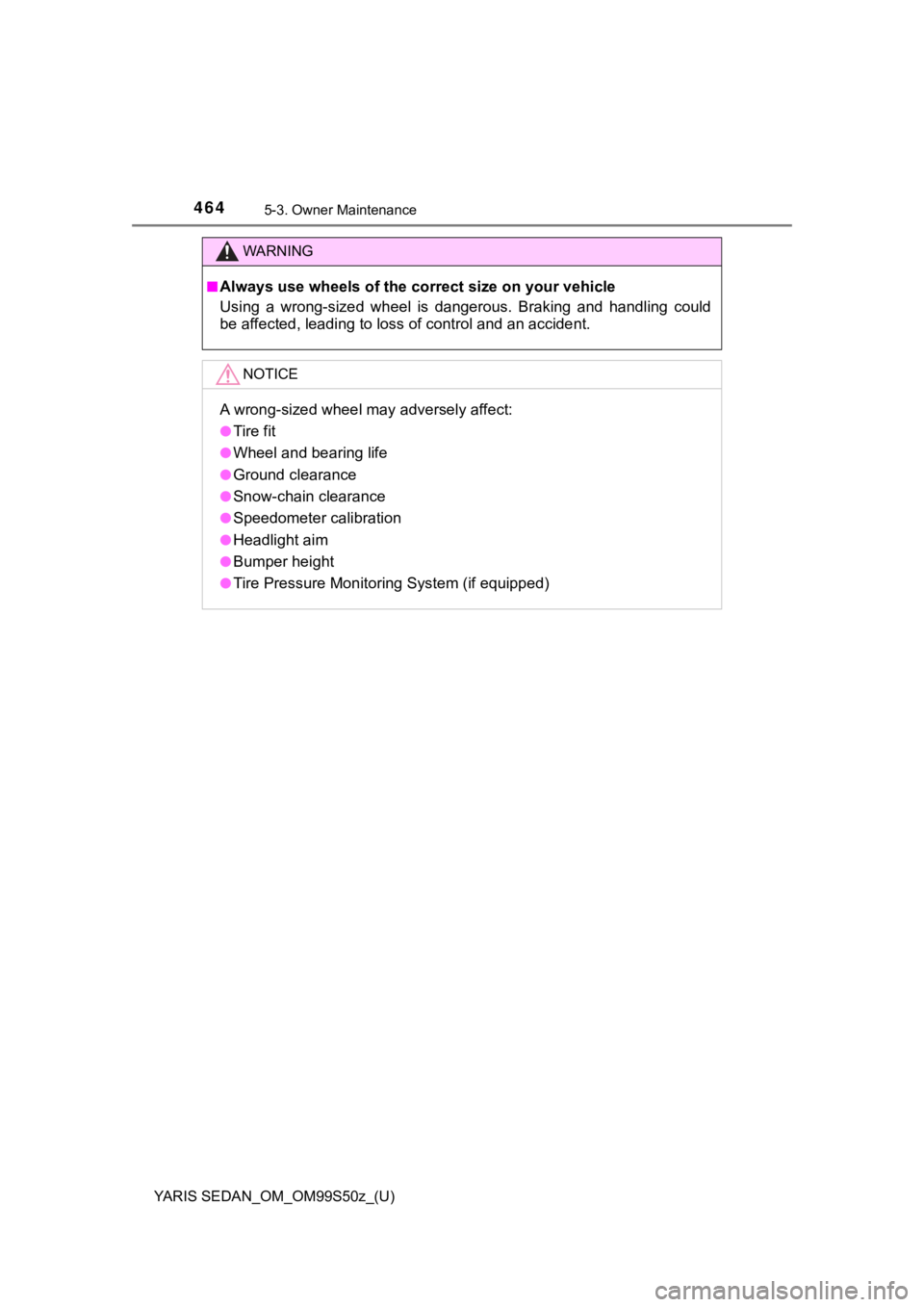
4645-3. Owner Maintenance
YARIS SEDAN_OM_OM99S50z_(U)
WARNING
■Always use wheels of the correct size on your vehicle
Using a wrong-sized wheel is dangerous. Braking and handling could
be affected, leading to loss of control and an accident.
NOTICE
A wrong-sized wheel may adversely affect:
●Tire fit
●Wheel and bearing life
●Ground clearance
●Snow-chain clearance
●Speedometer calibration
●Headlight aim
●Bumper height
●Tire Pressure Monitoring System (if equipped)
Page 501 of 600
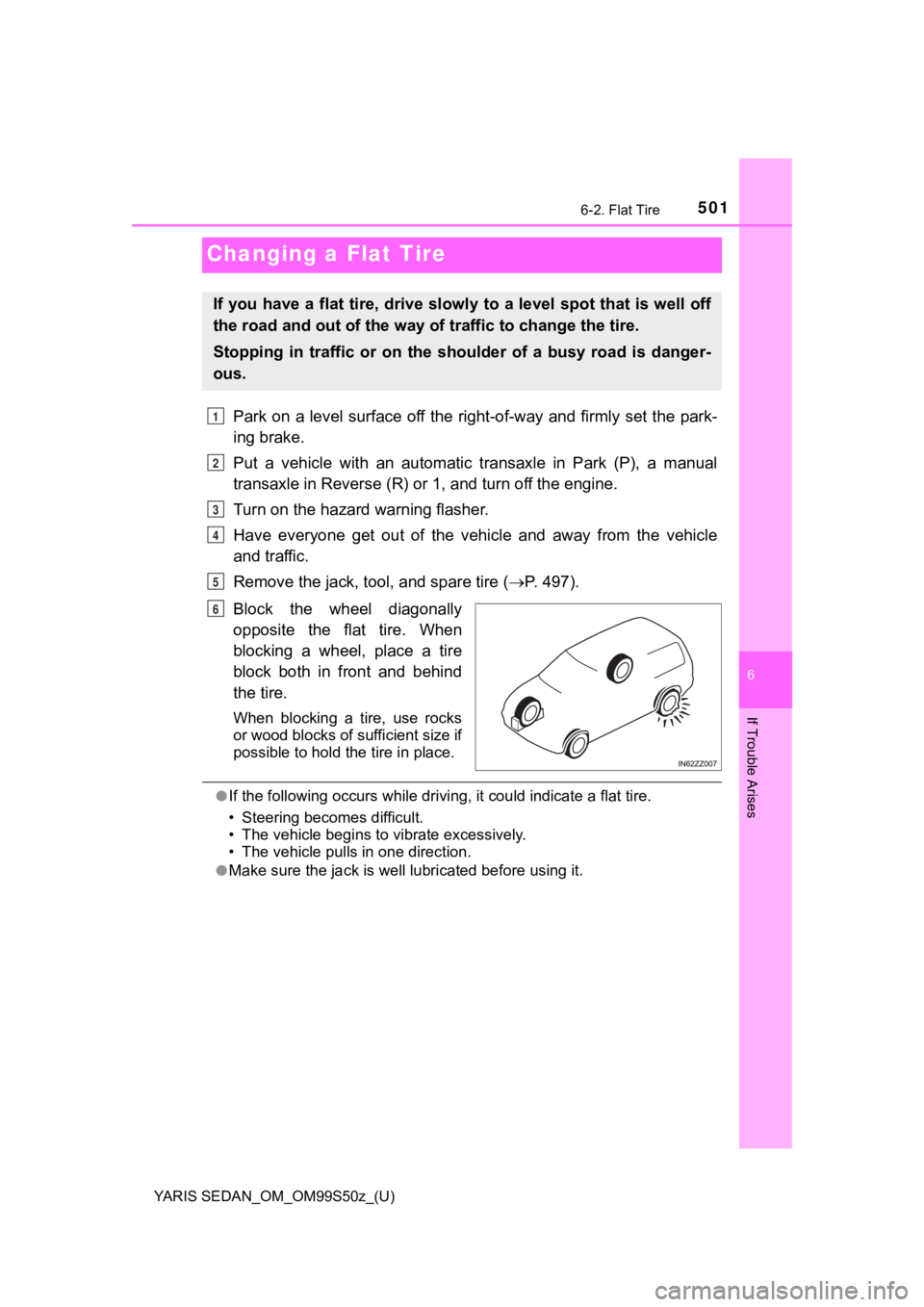
501
YARIS SEDAN_OM_OM99S50z_(U)
6-2. Flat Tire
6
If Trouble Arises
Changing a Flat Tire
Park on a level surface off the right-of-way and firmly set the park-
ing brake.
Put a vehicle with an automatic transaxle in Park (P), a manual
transaxle in Reverse (R) or 1, and turn off the engine.
Turn on the hazard warning flasher.
Have everyone get out of the vehicle and away from the vehicle
and traffic.
Remove the jack, tool, and spare tire ( P. 497).
Block the wheel diagonally
opposite the flat tire. When
blocking a wheel, place a tire
block both in front and behind
the tire.
When blocking a tire, use rocks
or wood blocks of sufficient size if
possible to hold the tire in place.
●If the following occurs while dri ving, it could indicate a flat tire.
• Steering becomes difficult.
• The vehicle begins to vibrate excessively.
• The vehicle pulls in one direction.
●Make sure the jack is well lu bricated before using it.
If you have a flat tire, drive slowly to a level spot that is w ell off
the road and out of the way of traffic to change the tire.
Stopping in traffic or on the shoulder of a busy road is danger-
ous.
1
2
3
4
5
6
Page 555 of 600

YARIS SEDAN_OM_OM99S50z_(U)
5557-7. Tire Information (U.S.A.)
7
Customer Information and Reporting Safety Defects
P215/65R15 95H is an example of a tire size and load index rati ng.
Here is an explanation of the various components of that tire s ize and
load index rating. Note that the tire size and load index ratin g may be
different from the example.
● P
Indicates a tire that may be installed on cars, SUVs, minivans and
light trucks as desig nated by the Tire and R im Association (T&RA).
If your tire size does not begin with a letter this may mean it is desig-
nated by either ETRTO (European Tire and Rim Technical Organiza -
tion) or JATMA (Japan Tire Manufacturing Association).
● 215
“215” is the nominal width of th e tire in millimeters. This three-digit
number gives the width in millimet ers of the tire from sidewall edge
to sidewall edge. In general, the larger the number, the wider the
tire.
● 65
“65” is the aspect ratio. This two-digit number indicates the t ire’s
ratio of height to width.
● R
“R” is the tire construction sym bol. R indicates “Radial ply construc-
tion”.
● 15
“15” is the wheel rim diameter in inches.
● 95
“95” is the Load Index. This two-or three-digit number indicate s how
much weight each tire can support.
● H
“H” is the speed rating. The speed rating denotes the maximum
speed for which the use of the tire is rated.
Page 557 of 600

YARIS SEDAN_OM_OM99S50z_(U)
5577-7. Tire Information (U.S.A.)
7
Customer Information and Reporting Safety Defects
■Maximum Load Rating
This number indicates the maximum load in kilograms and pounds
that can be carried by the tire.
■Maximum Permissible Inflation Pressure
This number is the greatest amoun t of air pressure that should ever
be put in the tire under normal driving conditions.
■Tread Wear, Traction and Temperature Grades
●Tread wear: The tread wear grade is a comparative rating based
on the wear rate of the tire when tested under controlled condi -
tions on a specified government test course. For example, a tire
graded 150 would wear one and one-half (1 1/2) times as well on
the government course as a tire graded 100.
● Traction: The traction grades, from highest to lowest are AA, A ,
B, and C. The grades represent the tire’s ability to stop on we t
pavement as measured under controlled conditions on specified
government test surfaces of asphalt and concrete. A tire marked
C may have poor traction performance.
● Temperature: The temperature grades are A (the highest), B and
C, representing the tire’s res istance to the generation of heat and
its ability to dissipate heat w hen tested under controlled cond i-
tions on a specified indoor laboratory test wheel.
■Snow Tires
In some heavy snow areas, local governments may require true
snow tires, those with very deeply cut tread. These tires shoul d only
be used in pairs or placed on all four wheels. Make sure you pu r-
chase snow tires that are the sa me size and construction type as
the other tires on your vehicle.
■SAFETY WARNING
The following safety warning appears on the tire’s sidewall. SE RI-
OUS INJURY MAY RESULT FROM: • EXPLOSION OF TIRE/RIM ASSEMBLY DUE TO IMPROPER MOUNTING-MATCH TIRE DIAMETER TO RIM DIAMETER;
NEVER EXCEED 40 psi (275 kPa) TO SEAT BEADS-ONLY
SPECIALLY TRAINED PERSONS SHOULD MOUNT TIRES.
• TIRE FAILURE DUE TO UNDE R-INFLATION/OVERLOADING/
DAMAGE-FOLLOW OWNER’S MANUAL AND PLACARD IN
VEHICLE-FREQUENTLY CHECK INFLATION PRESSURE AND
INSPECT FOR DAMAGE.